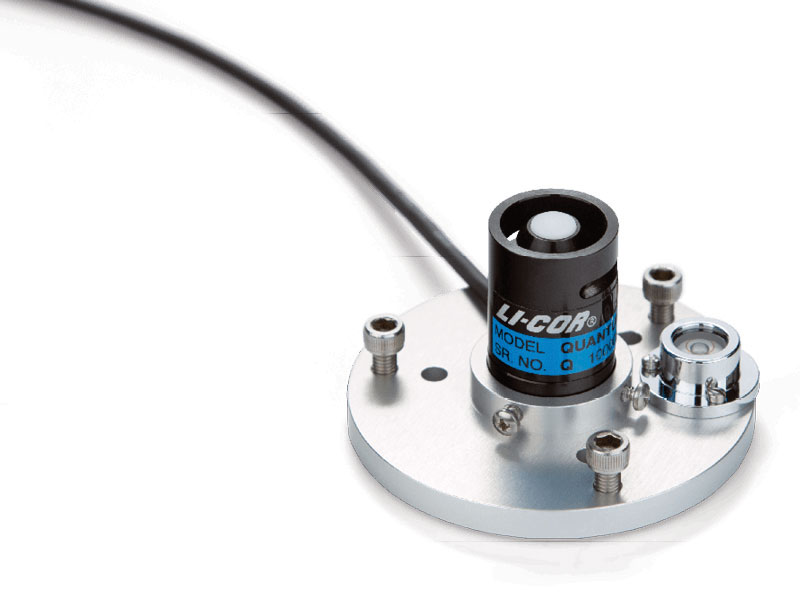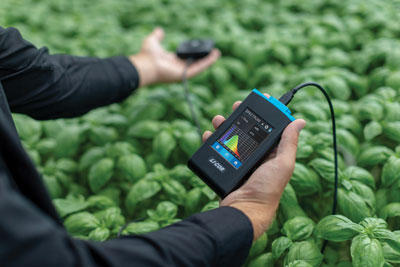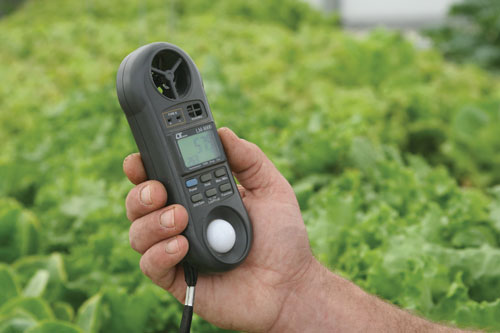2/1/2019
Must-Have Meters
Jennifer Zurko
For measuring light …
By Dave Johnson, Senior Product Manager—LI-COR Biosciences
One of the most important ongoing challenges for greenhouse growers is light management. Energy costs for artificial lighting can quickly cut into profit margins, while providing too much or too little light can impact your final yield and the quality of your product. When considering lighting in your greenhouse, you should ask yourself two main questions:
1. How much light are my plants getting?
2. What type of light are my plants getting?
Light management begins with measurement, and there are two main types of sensors used to measure the amount and type of light in your greenhouse: quantum sensors and portable spectrometers.
Quantum sensors
Not all light affects plants equally. Photosynthesis is driven primarily by light that occurs in the 400 to 700 nanometer wavelength range, also called photosynthetically-active radiation, or PAR. Quantum sensors are used to measure the intensity of PAR in your greenhouse.
How quantum sensors work: Quantum sensors like the LI-190R Quantum Sensor are small, portable and relatively inexpensive. At the top of a specially-engineered sensor housing is a diffuser that’s cosine-corrected, meaning that it’s equally sensitive to light from all angles and directions above the diffuser. Cosine-corrected sensors provide the most accurate measurements of radiation on a flat surface from all angles, which is important for a greenhouse where light is hitting your plants from many directions.
 This diffuser channels light into the housing where a filter eliminates light below 400 and above 700 nanometers, and a photodiode converts the light energy into an electrical current. The current is directly proportional to the intensity of PAR being captured by the sensor and is then computed into a user-readable intensity measurement.
This diffuser channels light into the housing where a filter eliminates light below 400 and above 700 nanometers, and a photodiode converts the light energy into an electrical current. The current is directly proportional to the intensity of PAR being captured by the sensor and is then computed into a user-readable intensity measurement.
Pictured: The LI-190R Quantum Sensor is small, portable and relatively inexpensive.
How to use quantum sensors: There are two main ways to use a quantum sensor in your greenhouse: with an instant readout device for spot measurements or with a datalogger for long-term measurements. Alternatively, the LI-190R Quantum Sensor can be integrated into greenhouse control systems.
Spot PAR measurements capture the instantaneous flux of photons with PAR wavelengths that your plants are receiving at any one point in time, which is typically reported in units of micromoles of photons per square meter per second. This data is used to answer questions like: Are my plants getting enough light right here? The answer to this question generally depends on your plant’s light requirements and impacts plant placement, spacing and the use of supplemental light.
You may also want to consider the total amount of light your plants receive on a daily basis, which cannot be extrapolated from instantaneous intensity measurements. The amount of supplemental lighting required to maintain consistent total daily lighting can change dramatically throughout the year, depending on your location, which may have a large impact on your energy costs. One of the most common ways of calculating total daily light is using a quantum sensor to calculate your greenhouse’s Daily Light Integral, or DLI, which reports a total number of moles (not micromoles) of photons per day (instead of per second).
Measuring DLI with a quantum sensor requires that measurements be taken at regular intervals throughout the day. The easiest way to do this is with a data logger like the LI-1500 Light Sensor Logger that can be programmed to automatically take and record the measurements at the regular intervals and calculate DLI for you.
Choosing a quantum sensor: Choosing an accurate sensor that most closely matches the ideal quantum response of PAR is important for ensuring that your lighting decisions reflect the reality of the light in your greenhouse. Inadvertently providing too much light may needlessly raise your energy bills, while providing too little light will likely have a strong bottom-line impact on the amount and quality of your yield.
Additionally, it’s important to select a sensor that measures PAR accurately in a mix of natural and artificial light from the sources you’re using in your greenhouse. Not all sensors are able to measure PAR accurately in a mix of natural and artificial light, or from specific artificial light sources.
Lastly, you should consider whether you’ll need an instant readout device (like the LI-250A Light Meter) or a data logger (like the LI-1500 Light Sensor Logger), depending on your individual needs.
Portable spectrometers
While plants use nearly all of the wavelengths included in the PAR range for photosynthesis, individual bands of light within this range affect plants differently. A rapidly developing body of literature is showing how manipulating the spectral composition of your light sources or choosing lights with specific spectral composition can impact morphology, pigmentation, flowering, germination, disease resistance and other plant characteristics. If you want advanced control over these characteristics, a portable spectrometer can be used to measure the spectral composition of your lights.
How portable spectrometers work: Whereas quantum sensors give a single measurement of the intensity of PAR in your greenhouse, the sensors used in spectrometers filter and measure light intensity at the individual-nanometer level. Some larger spectrometers chop and physically filter light to individual sensors, while smaller, portable spectrometers (like the LI-180 Spectrometer) use high-precision algorithmic correction in place of physical filtering. The major benefit of algorithmic correction is that it can be used with much smaller, portable sensors that can display instantaneous results in cost-effective, portable instruments.
Most spectrometers measure light between 380 and 780 nanometers. This range includes two bands not included in PAR: the near-ultraviolet band from 380 to 400 nanometer range and the far-red band from 700 to 780 nanometers. Research into the benefits of near-UV and far-red light is continuing to develop and more lighting manufacturers are beginning to provide lights specifically for these bands of light.
 Pictured: The LI-180 Spectrometer is a portable device that uses high-precision algorithmic correction in place of physical filtering that gives instantaneous results.
Pictured: The LI-180 Spectrometer is a portable device that uses high-precision algorithmic correction in place of physical filtering that gives instantaneous results.
How to use a portable spectrometer: Portable spectrometers are most commonly used to take instantaneous measurements. The results can be used to inform critical light management decisions, like the height of lighting above your plant canopy, plant spacing and even in the selection or manipulation of lights that allow for the adjustment of color intensity. Spectrometers can also be used to validate that your lights are providing the spectral composition that the manufacturer claims, and also for monitoring the spectra of your lights over time for degradation.
Rapid measurements can be taken on an individual basis to inform light management decisions, and some spectrometers can be used with a computer or mobile device to take continuous measurements that report changing spectral composition in real time. Most spectrometers will allow you to save and export your data for further analysis and long-term
monitoring.
Choosing a spectrometer: The first consideration for choosing a spectrometer is portability. Some spectrometers, like the LI-180 Spectrometer, are truly portable in that they can be taken to the greenhouse to capture and save data without a computer. Other spectrometers require a computer for operation, which is not always ideal in a greenhouse setting.
A second consideration for choosing a spectrometer is the breadth of capture and reporting range. Most, but not all, spectrometers will capture between 380 and 780 nanometers and report intensity at the 1-nanometer level. If you’re using near-UV and/or far-red light, be sure to get a spectrometer that measures these wavebands instead of just the PAR waveband.
Lastly, software and data-handling capabilities vary between spectrometers. Some spectrometers have a simple interface that isn’t user-configurable, while others, like the LI-180 Spectrometer, have an interface that can be configured by the user to display your particular variables of interest and transfer data from your spectrometer using a mobile device or computer.
For more information, visit licor.com/greenhouse.
For measuring temperature …
By Nicole Pulyado, Content Writer—Growers Supply & GrowSpan
Greenhouse temperatures determine a number of growing outcomes, including the rate at which plants mature, the quality of the final harvest, and ultimately, if the plant will survive at all. It’s a critical component in all growing operations that one shouldn’t leave up to chance. You must invest in the proper temperature meter to ensure you provide the best environment for your plants to thrive.
A temperature meter is an essential tool for any grower, necessary for monitoring plant conditions and making important climate adjustments to produce the healthiest crops possible. Growers Supply offers a wide selection of temperature meters and these devices help monitor the temperature of plants, growing media, air and more. Each meter offers different capabilities, so users should take their time when determining which one is best for their operational needs.
Wired Mini Digital Panel Meter: This compact temperature meter is a cost-effective solution for hobby growers who prefer the basics. It features a 1.4-in.-long, stainless-steel probe to insert into media and on the surface of plants to receive an accurate temperature reading. The waterproof sensor safeguards against accidental spills, something all too common within greenhouses, while the large digital display is easy to read. Users can easily mount this meter on a panel for safe-keepi ng and utilize the attached wire to read temperatures on plants within a 3-ft. radius. This meter can switch between Fahrenheit and Celsius scales, and is capable of reading temperatures between -58F (-50C) and 392F (200C).
ng and utilize the attached wire to read temperatures on plants within a 3-ft. radius. This meter can switch between Fahrenheit and Celsius scales, and is capable of reading temperatures between -58F (-50C) and 392F (200C).
Pictured: The Wired Mini Digital Panel Meter.
ValuTek Digital Pocket Thermometer: The ValuTek thermometer is another great option for small-scale growers. It includes additional features for convenience, while maintaining an inexpensive price point. A useful data-hold function enables growers to read and save multiple temperatures in a row, display the minimum and maximum temperatures taken and clear data when the meter is turned off. Also compatible with both Fahrenheit and Celsius temperature readings, this meter has a range of -40F/C to 300 (148C).
The splash-proof, drop-resistant meter comes with a protective cover for extra safety and features an on/off button with an automatic power off feature to preserve battery life. Growers can measure air, water and surface temperatures in their greenhouse for a complete picture of the environmental conditions over the span of a possible 5,000 hours of continuous use.
Infrared Thermometer with Laser: This infrared thermometer comes equipped with a backlit LCD screen and laser sensor for precise point-and-shoot readings. A one-second response time provides prompt readings, while the 15-second automatic shutoff saves battery life. This meter has a significantly greater temperature range, with the ability to read between -76F (-60C) and 932F (500C), and can provide readings in both Fahrenheit and Celsius scales. The lightweight meter is only 8.5 oz., making it easy to hold steady during continuous use when taking multiple measurements.
The infrared thermometer is a non-contact tool best suited for experienced growers, as it requires calibration to provide accurate readings and may need time to stabilize to the area’s temperature when conditions change. The meter also has a distance-to-spot reading of 12:1, so users should ensure any surface read is within appropriate range. Infrared meters are a great option for skilled growers in need of a measurement tool for their operation.
 FarmTek Pocket Wind/Weather/Light Meter: FarmTek’s handheld meter is a professional instrument that offers precision and accuracy with each measurement, utilizing four different sensors and a built-in microprocessor circuit. Although this meter is equipped to read temperatures between -148 F (-100C) and 2,372F (1,300C), it can also measure light, air velocity and relative humidity. (To guarantee the most accurate readings possible, growers should calibrate the device and allow it to acclimate to different environments before taking measurements.)
FarmTek Pocket Wind/Weather/Light Meter: FarmTek’s handheld meter is a professional instrument that offers precision and accuracy with each measurement, utilizing four different sensors and a built-in microprocessor circuit. Although this meter is equipped to read temperatures between -148 F (-100C) and 2,372F (1,300C), it can also measure light, air velocity and relative humidity. (To guarantee the most accurate readings possible, growers should calibrate the device and allow it to acclimate to different environments before taking measurements.)
Users will experience easy navigation through the numerous functions with an LCD display and six-button pad. The device can store measurement data, freeze current value readings, and display minimum and maximum values recorded. This meter is best for anyone managing a commercial greenhouse equipped with complete control over their growing setting. It helps to ensure a safe environment for growers and their plants by tracking temperature, light, humidity and ventilation—all important factors to monitor for success with large-scale growing.
For measuring water quality …
By Ryan Dickson, Assistant Professor of Greenhouse Horticulture & Controlled-Environment Agriculture—University of Arkansas
Meters or sensors that measure pH and electrical conductivity (EC) can be used to check the quality of irrigation water, calibrate fertilizer and acid injectors, and measure nutrients and availability for plant uptake in applied fertilizer solutions and the root zone. Several different types of pH/EC meters are available and tend to vary in size, cost and how they’re used in horticultural practice. It’s important for you to choose a meter that best meets the measurement needs of your operation.
Regularly testing pH and EC in the applied fertilizer and root substrate is a basic strategy to monitor the fertilizer program and prevent nutritional problems before crop loss occurs. Monitoring irrigation water EC is important because soluble salts can fluctuate throughout growing seasons, and influence fertilizer and irrigation practices. Checking pH and EC of applied fertilizer and hydroponic nutrient solutions helps determine whether fertilizer and mineral acid injectors are working and if sufficient nutrients are being supplied. Measuring root substrate pH and EC can indicate the quantity and availability of nutrients for plant uptake.
Regular calibration and maintenance of pH/EC meters ensures measurement accuracy and a long meter shelf life. pH sensors can become damaged if they dry out and should always be kept protected and in a proper storage solution when not in use. EC sensors can usually be stored wet or dry without damage. It’s important to keep standard calibration and storage solutions on stock for your pH/EC meter and refer to the instruction manual for guidelines on using, calibrating and storing meters.
Common types of pH and EC meters
• Hand-held and portable meters. Sometimes referred to as “pen” meters, hand-held and portable meters are battery-powered, low cost and practical for both small and large growing operations (Figure 1). Many are combination-type meters, meaning they measure both pH and EC. Hand-held/portable meters can be used to conduct in-house soil tests and can be carried around by growers to “spot-check” pH/EC in the greenhouse. Some pH/EC meters have special “needle” probes and are designed for sticking directly into substrates, whereas as many are designed to measure in liquid or extracted substrate solution.
• Bench-top pH/EC meters. These meters are placed on benches or tables as shown in Figure 2 and typically consist of separate sensors for pH and EC plugged into an electronic AC-powered console. Some consoles can log and record measurements, and may also have additional options for sensors that measure individual nutrients, dissolved oxygen and other parameters. Bench-top meters are common in research laboratories and for larger growers that process numerous samples in a centralized location. Because of the electronic console, bench-top meters are usually more expensive compared to hand-held meters.
• In-line pH/EC sensors. Sensors are installed “in-line” in irrigation pipes or reservoir tanks to monitor pH and EC of fertilizer solutions entering and leaving the crop (Figure 3). Sensors are often connected to environmental control computers and injection systems that automatically inject mineral acids/bases and fertilizer to maintain target pH and nutrient levels. In-line sensors for pH and EC are relatively inexpensive (<$1000), but there are extra costs associated with installation, plumbing and connecting to environmental control systems. In-line pH/EC meters are most common with larger growers, as well as hydroponic operations. GT

Figure 1. Hand-held and portable meters that measure both pH and EC (left). Using a hand-held pH/EC meter to conduct a 2:1 soil test (right).
Figure 2. Examples of bench-top meters, where the console and sensor on the left is for EC and on the right for pH. Some bench-top meters have both pH and EC sensors.
Figure 3. Electrical conductivity (EC) sensor plumbed into an irrigation pipe.
To learn how to calibrate fertilizer injectors using EC meters, check out the University of New Hampshire Extension article by Dr. Brian Krug titled “Fertilizer-Injector Calibration” (https://bit.ly/2D3Jude). For more information and step-by-step protocols on pH/EC soil testing, check out the GrowerTalks article “Test Takers” by Drs. Paul Fisher and Bill Argo (https://bit.ly/2VKMLoU) and visit www.backpocketgrower.com.